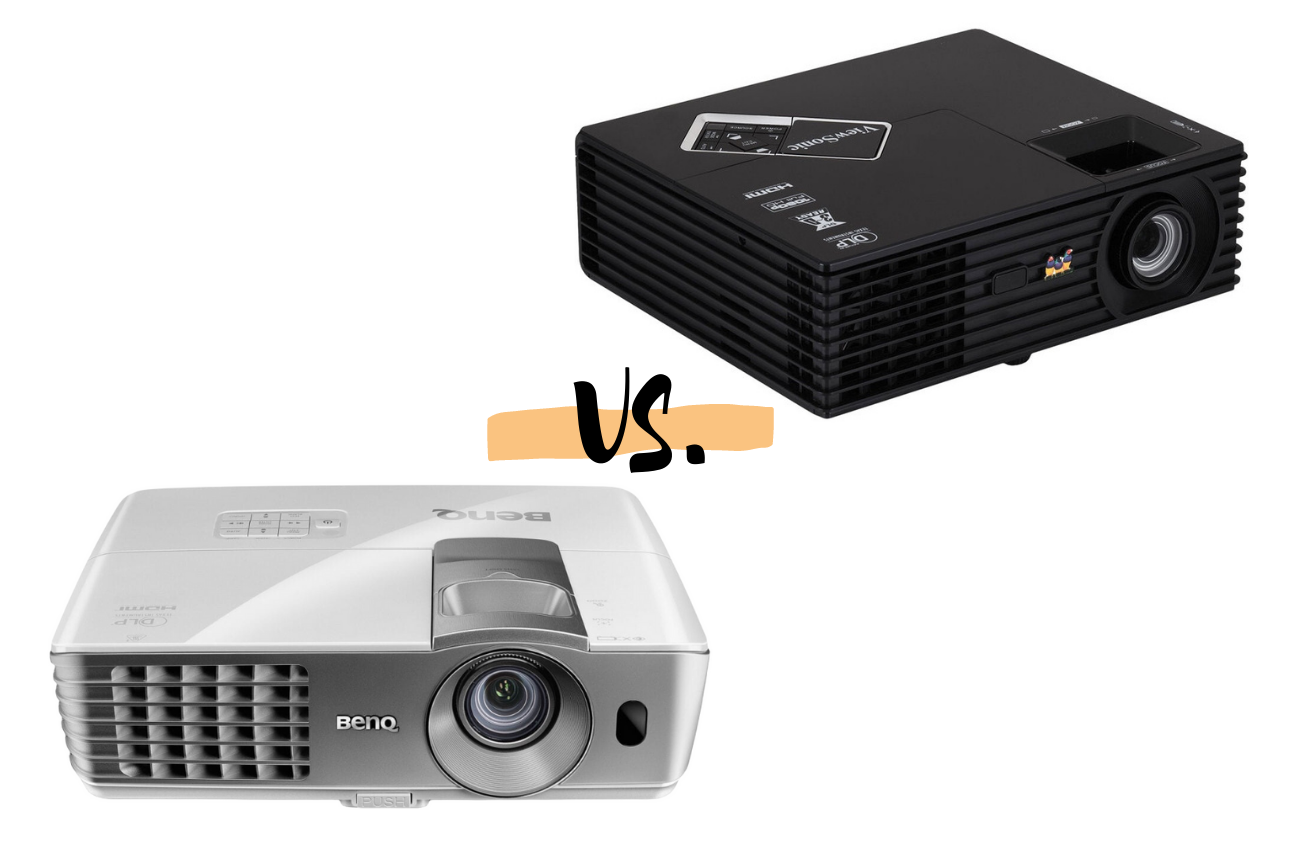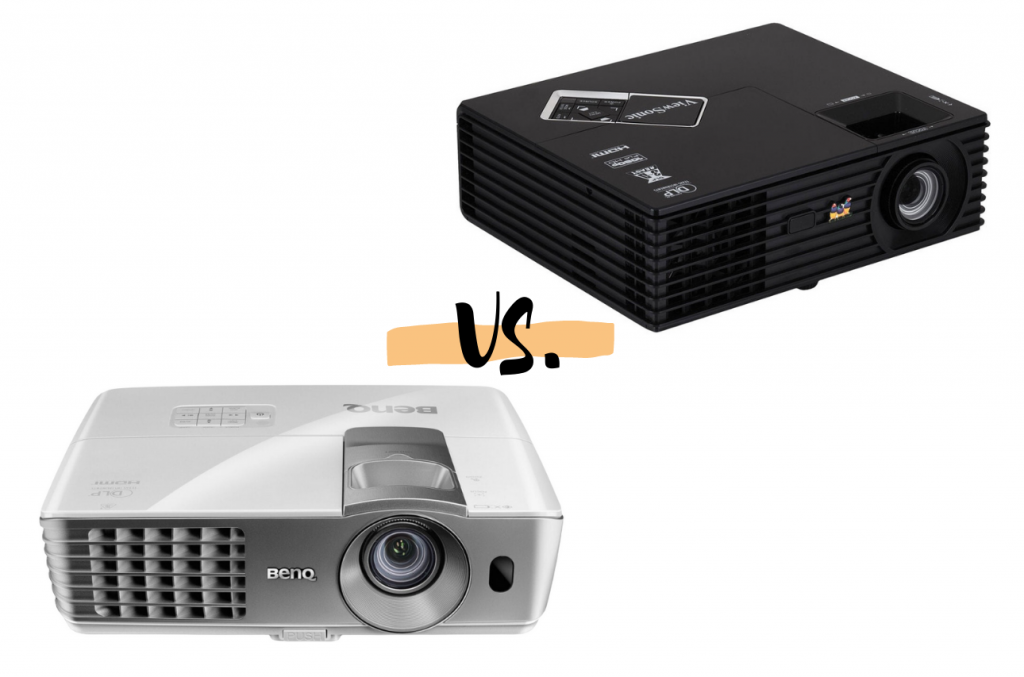
TABLE OF CONTENTS
There’s so much jargon in the projector market these days that buying can often become a confusing experience. So today I’m going to breakdown the differences between two terrific projectors, explaining what each one has to offer, so you can best determine, which one is perfect for you. We’re going to get into the details behind the numbers, words, and phrases written on the side of the boxes, and into the fine print, so that you’ll know exactly what you’re purchasing. This is the ViewSonic PJD7820HD vs BenQ W1070 comparison review.
| BenQ HT1085ST | BenQ W1070 | |
|---|---|---|
| Brightness | 2,200 Lumens | 2,000 Lumens |
| Resolution | 1920x1080 | 1920x1080 |
| Contrast Ratio | 10,000:1 | 10000:1 |
| Lamp Life | 6,000 hours (eco-mode) | 6,000 hours (eco-mode) |
| 3D | Yes | Yes |
| HDMI Port | Yes | Yes |
| Aspect Ratio | 16:9 (HD) | 16:9 (HD) |
| Image Size(cm) | 97 - 760 | 101 - 596 |
| Lens Shift | No | Vertical |
| Speakers | 10.0 W Mono | 10.0 W Mono |
| Audible Noise | 31.0 dB | 33.0 dB |
| Size(cm) (HxWxD) | 10 x 31 x 24 | 10 x 31 x 24 |
| Weight | 2.8 kg | 2.6 kg |
| Full Review | Coming Soon | Read Here |
| Amazon Price | Click Here | Click Here |
Portability and Design: ViewSonic PJD7820HD vs BenQ W1070
The portable market is very competitive, but both of these projectors are performing excellently within it, due to their low weight. The ViewSonic PJD7820HD comes in at 4.6 pounds while the Benq w1070 weighs 5.8 pounds out of the box. Measurements are almost identical too, with the w1070, being a little larger, though neither one could be viewed as prohibitive as far as size goes. The goal of manufacturers in the portable market is to make projectors as small as possible, and as light as possible, so both of these are successes. If beauty of design is what you’re looking for, there is a clear winner, and it’s the w1070’s stylish, curved look, because the pjd7820hd, is quite a dull looking box. Although, as I’ll explain in the performance section; it’s a pretty impressive box.
ViewSonic PJD7820HD 3200 Lumens 1080p HDMI Home Theater Projector (Discontinued by Manufacturer)– Not Currently available in US but available in Canada.
Performance: ViewSonic PJD7820HD vs BenQ W1070
Both of these projectors are labelled 3D Ready, and usually 3D Ready units don’t give you absolute 3D quality. When they do, it’s usually limited, so for example you’d be able to play 3D Blu-Rays, but not stream. 3D Ready, is a catch-all term used to explain, a large number of situations where something is missing, thus preventing straight out of the box full 3D. A common circumstance is where you have a 720p HD native resolution, in a projector that has a 3D transmitter, so while it will receive 3D signals; full 3D is out of the question because full 3D is 1080p resolution in each eye. The good news is that I’ve made some checks on the capabilities of each of these projectors, and each could well have been labelled full 3D, because they’re both 1080p, and both are set-up to handle, all major 3D formats, including the ‘Packed 3D’ found on Blu-Ray devices. They have 1.4a HDMI capabilities, which basically means they’re great at transmitting 3D data, so essentially you’ll be getting full 3D on both. I’d say the BenQ is marginally better because they’ve tripled the frame-rate to 48Hz, so you’ll be getting a typical full 3D, 24 frames per second in each eye, giving a cinema-quality feel to the viewing experience.
Both the w1070 and the pjd7820hd are full HD 1080p, and the Benq has DLP technology inside, projecting over 1 billion colors, with a 10,000:1 contrast ratio. This is good, but the ViewSonic has BrilliantColor technology inside, which is a little better, and comes from a company called Texas Instruments, who are regarded as the best manufacturers of color technology in the world. The ViewSonic also has a better contrast ratio at 15000:1, so you’ll see superior whites and blacks, compared to the BenQ. Unfortunately, some of the color modes on the ViewSonic pjd7820hd let it down, and you should avoid T-4 mode, as the result will be sunburnt images.
Regarding lumens, the Viewsonic has 3000, but lumens are difficult to count, and independent checks have clocked the lumens at 3500. What this means, is that the lumen performance is great. The W1070 meanwhile has only 2000 lumens, but again, the performance is excellent, so what might have been a large gap in terms of brightness, is actually a small one. You can read the full BenQ W1070 review for detailed information.
One of the only features in which one completely outperforms the other, is in sound. The pjd7820hd has 2 Watt speakers, while the w1070 has five times that power, with 10 Watt speakers. They also perform much better, because the venting system on the Viewsonic is below standard. The sound is still pretty good on the Viewsonic, but nowhere near the standard the w1070 can produce.
Conclusion
These projectors are so evenly matched, that it becomes about what individuals like the most. The color technology on the Viewsonic, certainly outperforms the Benq w1070, but is let down by it’s rather confusing and lacklustre color modes. Meanwhile the Benq w1070 has a better frame rate performance, so watching in 3D is better than on the Viewsonic. But, if you like glorious whites and blacks, the Viewsonic pjd1070hd has a higher contrast ratio, but worse sound. The Verdict: Too close to call.
